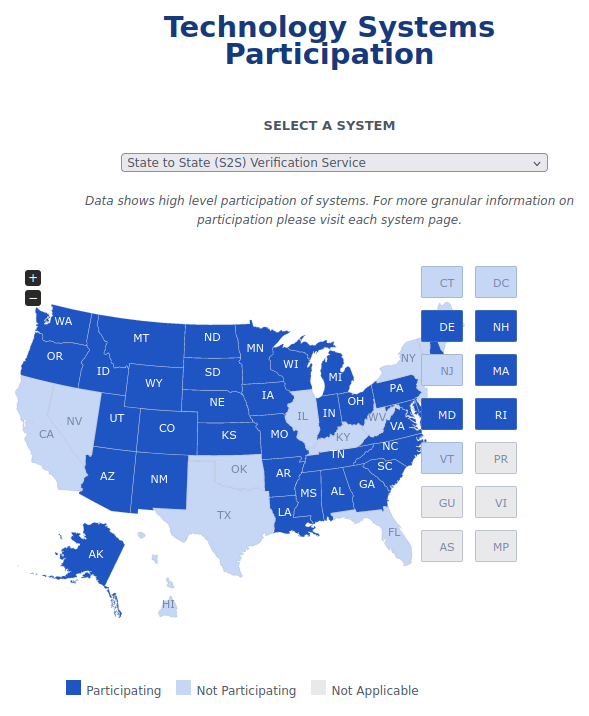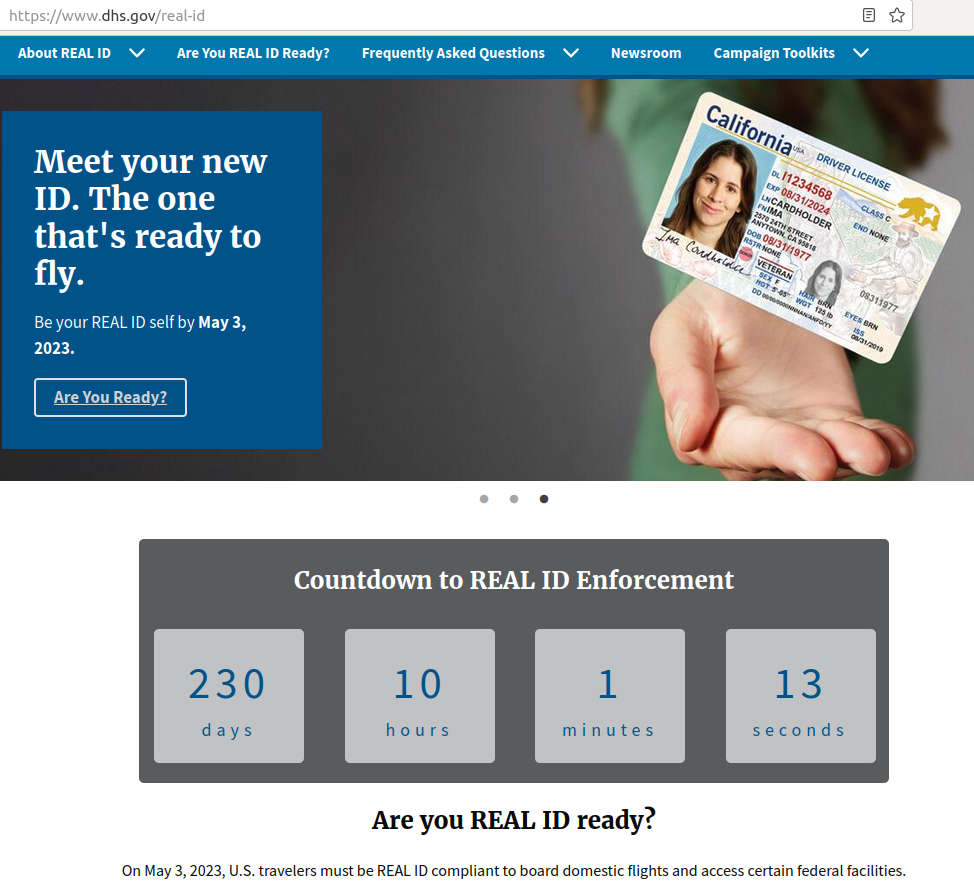Countdown to a crackdown on flying without ID
The Department of Homeland Security has added a Countdown to REAL ID Enforcement at airports to its website. But questions remain as to what this really means, despite our best efforts to find out.
What — if anything — will really change at Transportation Security Administration checkpoints when this countdown clock runs out on May 3, 2023?
Nothing in the law will change on that date. The REAL-ID Act of 2005 established criteria for which ID credentials can be “accepted” by Federal government agencies, in circumstances where individuals are required by Federal law or regulations to possess and/or show some evidence of their identity. But the consistent position of the DHS and TSA in litigation has been that no law or regulation requires air travelers to possess or show any ID. And the REAL-ID Act did not create any new requirement to have or show ID to fly.
Since the REAL-ID Act applies only to which IDs are accepted from those who choose to show ID to fly, it should have no effect, now or at at any date in the future, on those who don’t have, or choose not to show, ID to fly. They still have the right to fly without ID — as more than a hundred thousand people do every year — subject at most to a more intrusive administrative search of their person and baggage.
The “deadline” announced by the DHS and TSA might indicate plans for new regulations that would impose a requirement for air travelers to have or to show ID. But no such regulations have been proposed or included in DHS or TSA agendas of planned rulemaking.
Despite the lack of any apparent legal authority, however, it appears from the latest extrajudicial DHS and TSA rulemaking-by-press-release that these agencies plan to begin preventing anyone from flying without ID on or after May 3, 2023, on unknown grounds.
The following statement now appears on the DHS and TSA websites:
What happens if I show up without a valid driver’s license or state ID?
Starting May 3, 2023, every traveler will need to present a REAL ID-compliant license or an acceptable form of identification to fly within the U.S. Passengers who do not present an acceptable form of identification will not be permitted through the security checkpoint.
This would be a major change, with no legal basis, from current practice or any previously disclosed DHS or TSA plans.
In 2016 and again in 2020, the TSA announced that it planned to change the ID verification form that it has been illegally requiring some air travelers to complete since 2008. But in the face of objections from the Identity Project and others, the TSA never followed through on either of those proposals.
These proposals, as we noted in our comments, were made through the wrong procedure (a request for approval of a form, rather than rulemaking or legislation to establish a requirement for air travelers to show ID), and lacked ay legal basis. But at least they provided formal notice, after a fashion, and an opportunity for formal objections.
It appears that the DHS and TSA may now have decided to impose a new ID requirement to fly purely by proclamation, without even this fig leaf of administrative procedure.
Both the 2016 and 2020 proposals for revisions to TSA Form 415 would have prohibited residents of states not certified by the DHS as “compliant” with the REAL-ID Act from flying without ID, while continuing to allow residents of “compliant” states to fly without ID. The goal of these proposals, obviously, was to intimidate state governments into compliance, despite the fact that compliance by states was and is legally optional.
Compliance by a state with the REAL-ID Act requires sharing drivers license and state-issued ID information with all other states and territories, but none of the most populous states (California, New York, Florida, or Illinois) have uploaded their residents’ information to the national REAL-ID database to enable this sharing:
 But the DHS has now certified all states as “compliant” with the REAL-ID Act, despite the fact that none are. So a ban on flying without ID by residents of states not certified as compliant, as the DHS had apparently contemplated, would have no effect.
But the DHS has now certified all states as “compliant” with the REAL-ID Act, despite the fact that none are. So a ban on flying without ID by residents of states not certified as compliant, as the DHS had apparently contemplated, would have no effect.
The only state or territory where the DHS and TSA have ever tried to restrict travel by those without REAL-ID was American Samoa — the only jurisdiction subject to the REAL-ID Act whose residents aren’t US citizens — for a brief period in 2018. We’ve still received no response to our FOIA request, four years ago, for records about this experiment in REAL-ID enforcement in American Samoa. In practice, even during this brief enforcement period the TSA allowed residents of American Samoa to fly without compliant ID. Eventually, the DHS certified American Samoa as “compliant”.
Later in 2020, the TSA posted a request for proposals from contractors interested in providing outsourced “ID verification” services for air travelers without ID.
Whatever the merits or demerits of the ID verification proposals submitted by potential contractors (partially released in response to one of our FOIA requests, our appeal of which is still pending), the request for proposals seemed to imply that the TSA still recognized the need for procedures for processing of travelers without ID.
Why have the DHS and TSA changed their plans? On what basis do they now plan to begin preventing travelers without ID from flying? We still don’t know.
We requested the complete administrative record supporting the TSA’s 2016 proposal, which might have given us some idea of its rationale and legal basis. Five years later, our appeal of the TSA’s incomplete and improperly redacted response to our request remains pending.
Last month, however, after years of foot-dragging and buck-passing between the DHS and TSA, and after our appeal had been filed, we received an additional unsigned and undated file, DHS ANNOUNCEMENT OF TIMETABLE FOR REAL ID ENFORCEMENT FOR BOARDING AIRCRAFT, that gives some additional clues as to the thinking of the DHS and/or TSA.
This PDF of this file that we were sent was created in August 2022, but it appears to have been derived from a document written in 2015. None of the metadata pertaining to the original file was disclosed, and we weren’t told whether this file was created or found by the DHS or TSA, much less when, in what office, or by what official it was created. The TSA FOIA office sat on our request for five years, then referred this file to DHS headquarters before the file, stripped of all context, was finally released to us.
This 2015 internal DHS or TSA document explicitly contemplates the possibility that its “deadlines” might be postponed, as has happened repeatedly in the years since:
While the number of travelers potentially affected by initial enforcement in January 2018 will depend on the progress noncompliant states have made by then, the timetable allows DHS to retain flexibility to address operational impacts through the ability to grant extensions to states or, if circumstances at the time warrant, extend the initial enforcement date.
The primary goal of the “enforcement” threat is to induce state governments to comply:
Spurring state compliance. The credible prospect of TSA enforcement is necessary to bring the remaining states into compliance…. [M]any state legislators doubt DHS will enforce REAL ID for boarding aircraft. A firm timetable for TSA enforcement is critical to ensure further progress towards compliance.
Notably, the 2015 document indicates that the TSA had previously planned to accept “noncompliant” drivers licenses or state IDS in conjunction with secondary evidence of identity, but changed its mind:
TSA was unable to identify any identity documents secure enough to be used as a secondary ID in conjunction with a license from a noncompliant state (as originally envisioned in earlier interagency discussions) that was not already accepted without the license.
No records of these “interagency discussions” have been released, although they would clearly be responsive to our FOIA request.
The 2015 document also contains this remarkable estimate of how many would-be air travelers might be turned away at TSA checkpoints:
TSA estimates that, based on current state compliance efforts and possession of alternate forms of identification, between approximately 40,000 to 350,000 passengers per day — out of the average total daily travel population of 1.9 million passengers screened by TSA — could be denied boarding when initial enforcement takes effect in January 2018.
The current TSA checkpoint procedures for travelers without ID are mentioned only in a footnote:
TSA also considered requiring additional checkpoint screening for persons with a license from a noncompliant state, but rejected this option because of the cost associated with placing thousands of additional screeners at airport checkpoints nationwide and negative effects on the checkpoint screening mission. TSA explored but rejected coupling the additional screening regime with a random selection process to limit the volume of additional screening required. TSA believed that the selection process would place an undue burden on the screeners to explain why one person got enhanced screening over another, which would be difficult to defend as being fair, rational, and security-oriented and might distract TSA screeners from other security responsibilities. Lastly, TSA analyzed leveraging the knowledge-based authentication capabilities of its Identity Verification Call Center (currently used when a traveler has no ID), but the extraordinary cost of staffing the center to meet potential demand made this option infeasible.
An ID requirement to fly as a passenger on a common carrier isn’t just, and isn’t primarily, a “credentialing” requirement. An ID requirement is the prerequisite for surveillance and control of travel. Requiring travelers to show ID enables surveillance by allowing their travels to be linked to permanent individual travel histories. And it enables travel to be controlled through fly/no-fly decisions based on individual identities and the travel histories and other records linked to them.
Secret decision-making, disregard for the law, and delays in responding to FOIA requests make it difficult to know what the DHS and TSA are planning, much less what they will actually do. What’s clear is that their plans, threats, and deadlines have changed repeatedly and have been significantly influenced by their assessments of likely noncompliance with their demands — and seemingly not influenced at all by any assessment of their legal authority (or lack thereof) to require ID to fly.
This is why we need Congress to repeal the REAL-ID Act and enact the Freedom To Travel Act.
Will the TSA really start turning away thousands of would-be travelers next March? What sort of practical, political, and legal backlash will they face if they do? Only time, and the degree of resistance by the traveling public, will determine what happens.


Pingback: Links 17/09/2022: Details Emerge About Uber’s Ubercrack | Techrights
Pingback: How Banks Decide Where To Put Branches, And The Strange Role Parking Plays [Roundup] - View from the Wing
Recent US Supreme Court decisions have emphasized that government agencies and the Executive branch cannot legally make rules and laws. That is the prerogative of the Legislature. So unless Congress enacts a law signed by the President, there will be no law requiring a Real ID to fly.
Orwell was an optimist. Governments expand to fill whatever power they can get, and very rarely give it up. The TSA is the agency that thinks 1 person carrying 1 liter of a liquid is a potential threat, but 10 people traveling together each carrying 1/10th of a liter that they can then pool are not. Logic has little or nothing to do with their theatrical productions.
Pingback: DHS resets the clock on its threat to stop flyers without ID – Papers, Please!